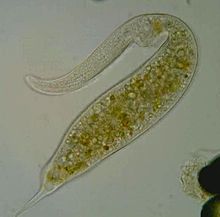- Dileptus
-
Dileptus 
Dileptus sp. Scientific classification Domain: Eukaryota Kingdom: Chromalveolata Superphylum: Alveolata Phylum: Ciliophora Subphylum: Rhabdophora Class: Litostomatea Subclass: Rhynchostomatia Jankowski, 1980 Order: Dileptida Family: Dileptidae Genus: Dileptus
Otto Friedrich Müller, 1773Dileptus is a genus of unicellular ciliate protists, belonging to the class Litostomatea. Members of the genus are found in fresh and salt water.[1] Like most of the free-living Litostomes,[2] Dileptus is an aggressive predator, carrying an arsenal of toxin-bearing trichocysts (toxicysts) in a prehensile proboscis, with which it stuns its microscopic victims before consuming them.[3]
Dileptus was first seen and described by O. F. Müller in 1773, who reports having found the creature "in water where duckweed dwells" ('"in aquis, ubi lemna hospitatur"). [4] He describes the organism in detail, recording its sharp posterior and its "long neck," which has a tendency to assume a spiral shape. The species Müller named Vibrio anser is generally understood to be a synonym of Dileptus anser. [5] [6] In a later work, Animalcula Infusoria, published posthumously in 1786, he repeats the earlier description of the creature and adds several illustrations of it [7]
Dileptus has become a model organism, used in the study of ciliary patterns, ontogenesis, conjugation and food acquisition [8]
Contents
Appearance and characteristics
Dileptus cell bodies are elongate, with a well-developed prehensile proboscis at the front end. The cytostome is at the base of the neck and is well fortified with stiff microtubular rods (nematodesmata). The surface of the cell is uniformly covered with cilia arranged in longitudinal rows. The body may narrow at the posterior, forming something like a tail. Multiple contractile vacuoles lie in a row along the dorsal surface.[9]
Classification
Müller named the creature he observed in 1773 Vibrio anser (anser being Latin for "goose"), placing it in a genus of long necked ciliates that included, among other species, the "swan-necked" ciliate Lacrymaria olor.[4]
In 1841, M. Félix Dujardin created the genus Dileptus and moved Müller's Vibrio anser to it. By the time a full revision of the genus was published in 1963, the genus included about 50 species. [8]
In 1974, John O. Corliss proposed the order Haptorida, to which Dileptus has generally been assigned under the subclass Haptoria.[10] [11]
However, in 2006, Strüder-Kypke et al. published the results of a molecular analysis of the Litostomes, which indicated that Dileptus is genetically, as well as morphologically, distinct from other Haptorian ciliates, and that they are, in fact, phylogenetically basal to that group. [12]
Recent research, combining genetic analysis with a study of physical characteristics (morphology), suggests that the Dileptids and their sister clade the Tracheliids belong in a subclass of their own. For this purpose, Vd'ačný et al. resurrect a subclass of Litostomatea first proposed by the Russian researcher A.W. Jankowski in 1980: Rhynchostomata, which they amend to Rhynchostomatia.
As a result, the class Litostomatea, which previously had two recognized subclasses, now has three: Haptoria. Trichostomatia and Rhynchomstomatia. [8]
In addition, the authors of the study divide the order Dileptida among two families: the Dimacrocaryonidae, most of whose members have a double macronucleus, and the Dileptidae, which have a multiple macronucleus (the nodes of which may be either scattered or arranged like a string of beads). Most of the known species of Dileptus fall into the latter group, although two were moved to the genus Rimaleptus within Dimacrocaryonidae. [8]
Video Gallery
Dileptus sp. Dileptus sp.
Dileptus sp.
Eukaryota Bikonta AH/SARAHSARHalvariaHeterokont ("S")Unikonta Apusomonadida (Apusomonas, Amastigomonas) · Ancyromonadida (Ancyromonas) · Hemimastigida (Hemimastix, Spironema, Stereonema)HolozoaDermocystida · IchthyophonidaFilozoaFilastereaCapsaspora · MinisteriaChoanoflagellateaCiliophora Spirotrichea (Stylonychia) · Litostomatea (Didinium, Balantidium) · Phyllopharyngea (Tokophrya) · Nassophorea (Nassula) · Colpodea (Colpoda) · Oligohymenophorea (Tetrahymena, Ichthyophthirius, Vorticella, Paramecium) · Plagiopylea (Plagiopyla) · Prostomatea (Coleps)OtherMyzozoa Plasmodiidae/Haemosporida (Plasmodium, Haemoproteus, Leucocytozoon)
Piroplasmida (Babesia, Theileria)Adele-Haemogregarina, Hepatozoon, KaryolysusEimeri-Cryptosporidiidae (Cryptosporidium)
Eimeriidae (Isospora, Cyclospora, Eimeria)
Sarcocystidae (Toxoplasma, Sarcocystis, Besnoitia, Neospora)Agamo-Rhytidocystidae (Rhytidocystis)GregariniaGregarinasina (Gregarina)ColpodellidaeChromeridaChromera velia, Vitrella brassicaformisWith a theca: Peridiniales (Pfiesteria, Peridinium) · Gonyaulacales (Ceratium, Gonyaulax) · Prorocentrales (Prorocentrum) · Dinophysiales (Dinophysis, Histioneis, Ornithocercus, Oxyphysis)
Without theca: Gymnodiniales (Gymnodinium, Karenia, Karlodinium, Amphidinium) · Suessiales (Polarella, Symbiodinium)
Noctilucales (Noctiluca)Syndiniales: Amoebophryaceae (Amoebophyra) · Duboscquellaceae (Duboscquella) · Syndiniaceae (Hematodinium, Syndinium)OtherRelatedReferences
- ^ Kudo, Richard (1954). Protozoology. Springfield, Illinois: C.C. Thomas. http://ia600301.us.archive.org/15/items/protozoology1954kudo/protozoology1954kudo.pdf.
- ^ Lynn, Denis. The Ciliated Protozoa: Characterization, Classification and Guide to the Literature. 3rd Edition. Springer, 2008. p. 187 ISBN 978-1-4020-8238-2 e-ISBN 978-1-4020-8239-9
- ^ Miller, Stephen (May 1968). "The Predatory Behavior of Dileptus Anser". Journal of Protozoology 15 (2): 313–19. doi:verisimilus [at] toolserver [dot] org. http://onlinelibrary.wiley.com/doi/10.1111/j.1550-7408.1968.tb02128.x/abstract.
- ^ a b Müller. O.F. Vermium Terrestrium et Fluviatilium, seu Animalium Infusoriorum, Helminthecorum, et Testaceorum non Marinorum, succincta Historia. 2 vols. 1773. Copenhagen and Leipzig. p. 46
- ^ Pritchard, Andrew (1861). A History of Infusoria, including the Desmidiaceae and the Diatomoaceae,British and Foreign. 4th Ed.. London: Whittaker. pp. 63. http://ia700308.us.archive.org/1/items/historyofinfusor00prit/historyofinfusor00prit.pdf.
- ^ "Dileptus anser". Systematics of Protozoa. National Institute for Environmental Studies. Tsukuba-City, Japan.. http://www.nies.go.jp/chiiki1/protoz/morpho/dileptus.htm#Dileptus%20anser.
- ^ Müller, O.F. (1786). Animalcula Infusoria, Fluvia Tilia et Marina. Hauniae, Typis N. Mölleri. http://ia700500.us.archive.org/15/items/animalculainfuso00ml/animalculainfuso00ml.pdf.
- ^ a b c d Vd'ačný, Peter; et al. (June 2011). "Morphological and molecular phylogeny of dileptid and tracheliid ciliates: Resoltuion at the base of the class Litostomatea (Ciliophora, Rhynchostomatia).". European Journal of Protistology (Epub ahead of print). PMID http://www.ncbi.nlm.nih.gov/pubmed/21641780.
- ^ Carey, Phillip G., Marine Interstitial Ciliates: An Illustrated Key. Chapman and Hall, 1992, ISBN 978-0-412-40610-2
- ^ Corliss, John (1974). "The Changing World of Ciliate Systematics: Historical Analysis of Past Efforts and a Newly proposed Phylogenetic Scheme of Classification for the Protistan Phylum Ciliophora". Systematic Zoology 23 (1): 115. http://www.jstor.org/pss/2412242.
- ^ Lynn, Denis (2008). The Ciliated Protozoa: Characterization, Classification and Guide to the Literature. 3rd Ed.. Springer. pp. 439. ISBN 978-1-4020-8238-2.
- ^ Strüder-Kypke, MC; et al. (August 2006). "Molecular Phylogeny of Litostome Ciliates (Ciliophora, Litostomatea) with Emphasis on Free-Living Haptorian Genera". Protist 157 (3): 261–78. PMID 16843062.
Categories:- Protista
- Ciliates
Wikimedia Foundation. 2010.

